Search the Special Collections and Archives Portal
Search Results
Las Vegas High School Reunion Biography Collection
Identifier
Abstract
The Las Vegas High School Reunion Biography Collection (1983) consists of class rosters, biographies of graduates, and photocopies of original programs from the four graduating classes of 1933 to 1936. The information specific to each year is compiled into its own handmade scrapbook. The materials were created for the 50th reunion of the class of 1933, and the event also included the classes of 1934, 1935, and 1936.
Archival Collection
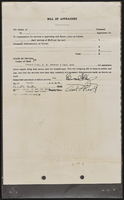
Stewart family real estate documents
Date
Archival Collection
Description
Stewart family real estate documents
Text
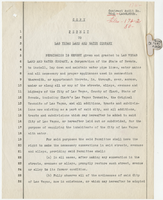
Permit to Las Vegas Land and Water Company to lay pipelines and water mains along and through the streets and alleys in Las Vegas, February 25, 1930
Date
Archival Collection
Description
Permit for the water company to lay down and maintain water lines to supply residents of Las Vegas with water. The permit also gives the company access to the streets, alleys, avenues, and highways in Las Vegas to lay water lines. Application for the permit is linked below. Contract Audit No. 7641
Text
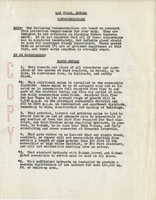
Report of Las Vegas fire protection recommendations from the Board of Fire Underwriters of the Pacific, July 1949
Date
Archival Collection
Description
Fire protection recommendations for the city of Las Vegas including an April 13, 1949 fire flow test report provided by the Board of Fire Underwriters of the Pacific for Las Vegas.
Text
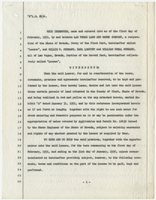
Lease agreement between Las Vegas Valley Land and Water Company and Willie T. Stewart, Earl Leavitt, and William Udell Stewart, Las Vegas, February 1, 1951
Date
Archival Collection
Description
Lease of the Las Vegas Ranch by Las Vegas Land and Water Company to Willie T. Stewart, Earl Leavitt, and William Udell Stewart. The document lists 13 terms and conditions including such topics as land use, water use, and fiscal responsibilities. "Exhibit A", which is referenced below, is mentioned in lease term number two and shows specific areas of the ranch . The area outlined in yellow was to be used for dairy operations and the red outlined area for grazing purposes.
Text
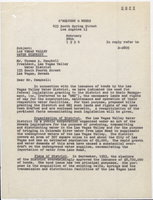
Letter including legal opinion from Franklin T. Hamilton (Los Angeles) to Thomas A. Campbell (Las Vegas), February 24, 1954
Date
Archival Collection
Description
Mr. Hamilton, as representative of the law offices of O'Melveny & Myers addresses Mr. Campbell, president of the Las Vegas Valley Water District, outlining facts about the Las Vegas Valley Water District, Basic Management Inc., history of land and water rights, and the issuance of bonds.
Text
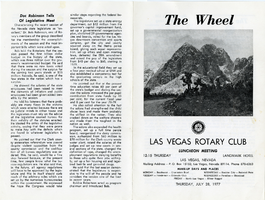
The Wheel Las Vegas Rotary Club newsletter, July 28, 1977
Date
Archival Collection
Description
Text

Mabel Hoggard: lesson plans and textbooks
Date
Archival Collection
Description
Folder of materials from the Mabel Hoggard Papers (MS-00565) -- Educational work and legacy file. The folder contains a "Teachers' manual for human geography," teaching notes, notes on United States history, assignments, and an exam book with handwritten notes. Many of the documents are handwritten.
Mixed Content

Interview with Navor Tito Valdez, June 20, 2005
Date
Archival Collection
Description
Text

Transcript of interview with Liliam Lujan Hickey by Layne Karafantis, March 18, 2010, & March 25, 2010
Date
Archival Collection
Description
Liliam Lujan Hickey is best known in the state of Nevada for being the first Hispanic woman elected to the State Board of Education as well as for the enormous contributions she made while serving from 1998 to 2000. For this, an elementary school in Clark County bears her name. Despite many obstacles, Liliam has continually dedicated herself to standing up for the causes she believes in, such as providing preschool education to the underprivileged, preparing youth to enter the workforce, helping other Hispanics run for office, and proving that with enough courage anyone can accomplish their dreams. Born in Havana, Cuba in 1932, Liliam led a sheltered life that revolved mostly around her studies at a French Dominican school. She met her first husband, Enrique Lujan, when she was only sixteen and they wed soon after. Enrique was twelve years her senior, owned many casinos on the island, and provided a luxurious existence for Liliam and their three children. However, this lifestyle abruptly changed when Castro assumed power in 1959 and Liliam and her family were compelled to relocate to the United States. In Miami, Enrique assisted other refugees financially, hoping that his wealth would remain secure in Cuba. He was wrong. This left the family destitute. In addition to casinos, Enrique had been Cuba?s coach for the Olympics. He moved the family to York, Pennsylvania, where he hoped to find work at the York Barbell Company. Liliam, who had been accustomed to having maids and nannies in Cuba, found herself doing all the housework while she also worked in a factory. The change could not have been more dramatic and the living conditions became unbearable. The family chose to move to San Diego in a Volkswagen Minivan with the hope for a better life. The next few years brought many transitions. Things did turn around in San Diego, and Liliam she recalls her years in southern California as some of the happiest of her life. Liliam found a job working at the Scripps Clinic in La Jolla. After a few years, Enrique found a job in Las Vegas and the family moved again. In Las Vegas, Liliam gave birth to her fourth child, Mary, and life once again became financially difficult for the family. In 1972, the situation grew worse with Enrique?s untimely death. Liliam was a widow at forty years of age. She had to teach herself how to drive a car, write checks, and perform financial tasks that Enrique had insisted on managing while he was alive. Determined not to give up, however, she worked tirelessly to keep the family together. Amidst all this, a friend introduced Liliam to Tom Hickey, and after a brief courtship they were married in 1981. Within a few years, Liliam became active in politics, running for the State Board of Education. Her campaign manager advised her that voters would not be receptive to photos of a Hispanic woman on billboards, and to capitalize on the name “Hickey,” which was a recognizable name because her husband was an assemblyman. She took the manager?s advice and was elected in that campaign and for two more terms, the maximum limit for the office. After the first race, she proudly displayed her face on billboards across the state. During her time at the State Board of Education, Liliam dedicated herself to helping all children receive a better education in Nevada, not only Hispanics. She co-founded the Classroom on Wheels [COW] program, which brought buses to poor neighborhoods to provide pre-school education. She established Career Day, which pairs high schools students with business professionals in an effort to help them make the transition into the workforce. While the COW program is no longer running, 8 Career Day still operates and awards scholarships in Liliam?s name annually, which helps youth receive the educational opportunities they need to succeed. And she involved Hispanic youth in Boy Scouts by bringing ScoutReach to the Las Vegas valley. Lujan Hickey worked in a wide array of other community organizations. In the 1970s, she began to work with Circulo Cubano, which later became the Latin Chamber of Commerce, and she would later belong to the National Chamber of Commerce. A longstanding member of the League of Women Voters, Liliam saw the need to get Hispanics more involved in politics in the state. Her story is one of great inspiration, and when asked why she does it, she simply replies with a smile, “I love life.” Hickey?s narrative offers the reader a glimpse of the experiences of the Cuban refugee experience in the U.S. in general. Specific to Las Vegas, it provides a rare story of the experiences of early Latinas in the political and economic development of Las Vegas in the last half of the twentieth century.
Text
